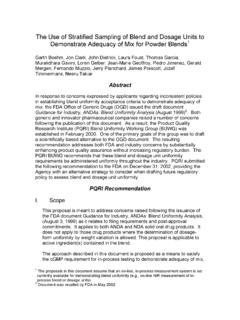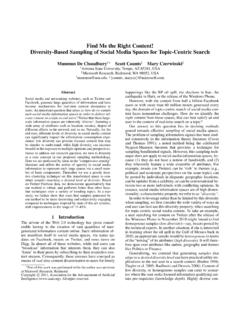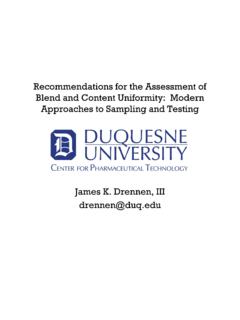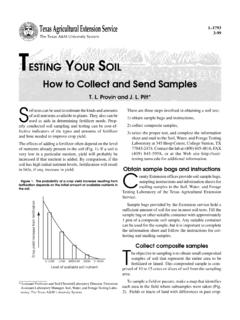Transcription of CHAPTER 7 SAMPLE COLLECTION PROCEDURES
1 The Wastewater Treatment Plant Operators Guide to Biosolids sampling Plans7-1 ESSENTIAL ELEMENTS OF A sampling PLAN Goals of the sampling Plan Description of the Facility Generating Sludge Data Quality Objectives Selecting and Describing sampling Points SAMPLE COLLECTION PROCEDURES SAMPLE Handling PROCEDURES Evaluation of Completeness Record-Keeping and Reporting PROCEDURES After establishing data quality objectives and selecting appropriate sampling points, the nextstep in developing a sampling plan is to establish and describe the SAMPLE COLLECTION proce-dure.
2 To ensure consistency, all elements involved in SAMPLE COLLECTION must be to sampling , all sampling equipment and PROCEDURES , as well as methods of cleaningand preparing sampling equipment and containers, should be determined. Safety equipmentand precautions should be described. This attention to detail will help minimize and biosolids can have a wide range of physical characteristics. Solids content can rangefrom 1 percent to over 90 percent. As a result, consistencycan vary from liquid, to mud-like, to a dry pelletized equipment needed to SAMPLE a particular material mustbe appropriate for the physical properties of your consistency can vary from a low percent solids (L) to a high percent solids (R).
3 Equipment types sampling equipment is generally divided into samplersused for liquids or solids. Listed below are some com-monly used and commercially available samplingdevices for collecting sludge samples . Common devices used for sampling liquid or flowable materialGraduated Cylinders or Pitchers:Vessels made of glass,plastic, or stainless steel can be used to SAMPLE liquid orsemi-solid sludge collected from taps. The vessel can beattached to a pole or other device to extend its reach or tosample from open Liquid Sludge Sampler:A composite liquidsludge sampler or coliwasa can be used to collect flow-able sludge from a lagoon, tank, or other sludge contain-ment areas.
4 A core or depth profile can be collected withthis device. The coliwasa is typically a 5-foot long (longerversions are commer-cially available) tubefabricated frommetal, glass, or plas-tic. The bottom is fit-ted with a mechanism that can be opened and closedto collect a SAMPLE when the coliwasa is loweredinto liquid sludge. To use the device, the bottom isopened and slowly lowered into the sludge. Oncethe intended depth is reached, the bottom of the col-iwasa is closed and the SAMPLE is collected. Thesample collected is a composite of the sludge profileat that point.
5 A sludge judge is a similar devicethat is typically used to measure the depth of thesludge blanket in a lagoon or tank. However, aftermeasuring the depth of the blanket, a SAMPLE ofsludge can be collected for analysis. Common devices used for sampling solid or semi-solid material Thief Sampler:This is most appropriately used for drier and more granular sludgeproducts such as compost or pellets. It is a useful tool for collecting a core samplethrough the depth of a mass of material. The device is composed of two slotted tubes,one of which fits inside the other, and typically made of metal.
6 Rotating the inner tubecloses the sampler. A similar sampling device known as a Missouri D probe can alsobe used to collect dry or granular sludge. To use this type of sampling device, the thief is pushed into the material to be sampledwith the slots opened and oriented upward. Typically, the thief has a pointed or taperedend to facilitate penetration. Once the thief has reached the desired depth, the innertube is rotated to close the slots and collect the :This device is most useful for sampling dewatered sludge that has manure ormud-like consistency.
7 Like the thief, a trier is ideal for collecting core samples and isChapter 7: SAMPLE COLLECTION Procedures7-2A sludge judge can be used to collect sludge Cylinder The equipment needed tosample a particular materialmust be appropriate for thephysical properties of Wastewater Treatment Plant Operators Guide to Biosolids sampling Plans7-3 Missouri D ProbeTrier Soil Auger, note drill-like cuttersused in a similar manner. The trier is comprised of a single metal tube, generally stain-less steel or brass, which has been cut in half along its length.
8 The end of the tube issharpened to allow the trier to be more easily pushed into the material being available probes for soil sampling have a similar construction and canbe used for the same :A soil auger can be used to collect sludge samples that have hardened or beencompressed. The auger is particularly useful when a trier or thief cannot be successfullypushed into the material being sampled. Augers typically consist of a metal handle andextension attached to spiral drill-like metal blades. The auger is used to drill into thesludge to collect a SAMPLE .
9 The material can be collectedover the entire depth of the drilled hole to form a com-posite SAMPLE , or the material can be collected from aspecific depth in the sludge for a grab SAMPLE . Shovels and Scoops:These tools are useful for sam-pling granulated, powdered, or other loose sludge. Theyare particularly convenient to use when dewatered sludgeis being conveyed within the Equipment:The tools described above areemployed for the actual COLLECTION of sludge , a variety of other items are needed for sam-pling biosolids. Table 7-1 provides a list of typicalsludge sampling equipment.
10 Other commonly-used sampling tools Equipment SelectionAll equipment that is used to collect and prepare sludge samples must be prepared so that itdoes not contaminate or react with the material being sampled. Contamination can arise ifequipment is improperly cleaned or is made of materials that are released into the SAMPLE .(Galvanized or chrome-plated implements must be avoided.) Relatively inert materials such asTeflon, glass, or stainless steel are typically used for sampling equipment or , Teflon and stainless steel are expensive, and glass is heavy and fragile.


![[PDF] XDM Quad Single-Use Mixing System DATA SHEET](/cache/preview/c/3/6/4/b/f/9/e/thumb-c364bf9ea947704074f9743161b874c0.jpg)




